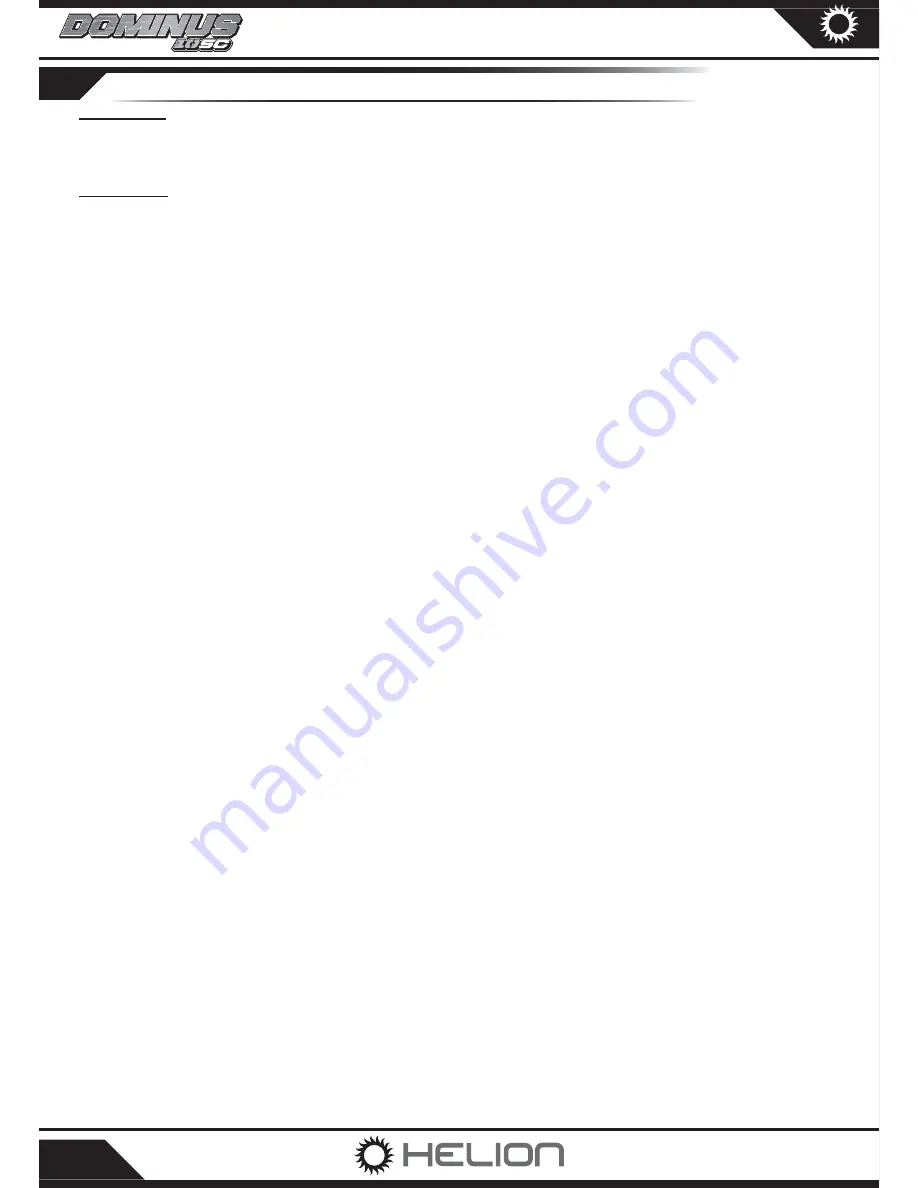
#
CARE AND MAINTENANCE...
10
General Care:
Always use clean, dry cloth or so
Ō
bristle brush to clean your equipment
Never use chemical cleansers to avoid damage to the sensi
Ɵ
ve electronics and plas
Ɵ
cs
Maintenance:
We want you to enjoy your product to its fullest poten
Ɵ
al. For this to happen it is important to keep your product clean
and properly maintained. Lack of cleaning and maintenance can cause component failure. For best and con
Ɵ
nued
performance from your product it is recommended to brie
y inspect your product for damage every few runs. Typically,
a good
Ɵ
me to do this is when changing the ba
Ʃ
ery or while it is charging. If a problem is discovered, stop use immedi-
ately and perform repairs or seek assistance. Con
Ɵ
nued use of failed components can cause more unnecessary damage
to your product. Always remember to use genuine replacement parts from your local HobbyTown USA® dealer. Below
is a list of items for inspec
Ɵ
on. Inspec
Ɵ
on should not be limited to this list; if you no
Ɵ
ce any problem, listed or not, it is
recommended to give it proper a
Ʃ
en
Ɵ
on.
1. Electronics: Although the ESC and servo included in your vehicle are waterproof the receiver is not, however it is
contained in a water resistant box. It is recommended that you avoid submersion of the vehicle however light run-
ning in puddles and light rain should not be damaging. If you plan to run for extended periods of
Ɵ
me in light or
heavy rain It is recommended to secure the receiver in an addi
Ɵ
onal waterproof membrane. Since the Helion HRS-3
receiver is a micro size receiver,
ƫ
ng it into a balloon is fairly easy. Simply insert the receiver with connected wir-
ing into a balloon and secure the balloon around the wires with an addi
Ɵ
onal rubber band as close to the receiver
as possible, allowing the most exposure of the antenna as possible.
2. Antenna: To achieve full opera
Ɵ
ng range with your radio system, it is cri
Ɵ
cal that the receiver antenna be installed
properly and undamaged
a. Inspect any exposed antenna for cuts or abrasions
b. Ensure there are no kinks in the antenna or antenna tube
c. Never fold the end of the antenna over the tube, this will reduce the range and damage the antenna
3. Gears: Periodically remove the gear cover to inspect the gears and ensure there is no debris in the gear compart-
ment
a. Proper gear mesh se
ƫ
ng is crucial for proper opera
Ɵ
on and life of gears in your product. It is important to
have the pinion gear (a
Ʃ
ached to motor) as close to the spur gear (a
Ʃ
ached to drive sha
Ō
) as possible yet
while providing a minimal amount of backlash. Backlash is the rota
Ɵ
on one gear has to make before contact-
ing the other. Having the gear mesh set too
Ɵ
ght will cause excess load on the electrical components and may
cause premature failure. Having gear mesh set too loose will cause excess wear and possible skipping of teeth
during opera
Ɵ
on thus causing excess wear and premature failure
b. Checking the gear mesh
i. Remove the spur gear cover
ii. Check how much movement is allowed of the spur gear before the pinion gear moves (this is purely by
feel, not visual). Check this movement in mul
Ɵ
ple places by rota
Ɵ
ng the spur gear approximately 1/6
rota
Ɵ
on and checking again.
iii. If the spur gear is allowed to move more than a very small amount, or if it there is no backlash, the gear
mesh must be adjusted. If there is a lot of movement, it is recommended to a
Ʃ
empt to
Ɵ
ghten the mesh.
A
Ʃ
empted adjustment should only improve the situa
Ɵ
on; if the mesh was correct to begin with, you
will know what that feels like, and if it wasn’t correct, it will be when you are done a
Ō
er following these
procedures.
iv. Se
ƫ
ng the gear mesh
01). Loosen the two screws securing the motor plate to the motor mount, only enough to allow the
plate to move. Check and ensure there is no debris in the gears a
ī
ec
Ɵ
ng the mesh
02). Slide the top of the motor plate away from the center of the chassis, insert a strip of notebook
paper between the pinion and spur gear, then slide the motor plate back un
Ɵ
l there is no backlash.
You will have to push rela
Ɵ
vely hard to ensure the paper is pressed all the way into the teeth
03). Hold the motor snugly in posi
Ɵ
on while re
Ɵ
ghtening the screws, top
rst, then bo
Ʃ
om
04). Rotate the spur gear to feed the paper out of the mesh, re-check the gear mesh and adjust again if
necessary
v. Re-install the spur gear cover











































